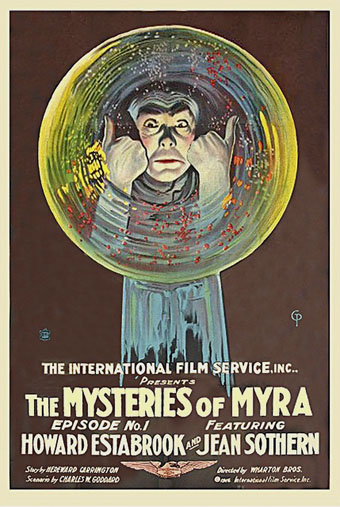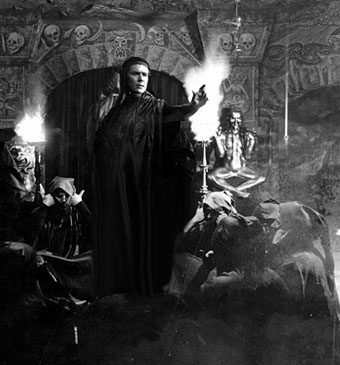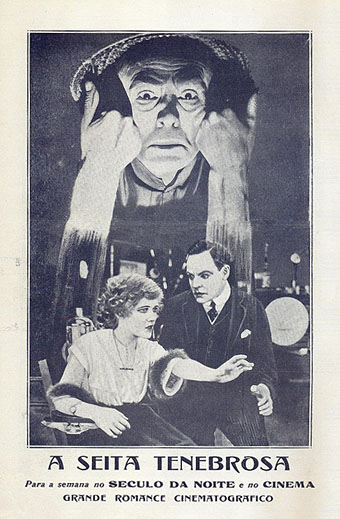
Aleister Crowley in 1912.
Back in 1999 I found myself making notes for a short essay on the subtle and often tenuous presence of Aleister Crowley in cinema. Despite Crowley’s reputation in the early years of the 20th century—famously labelled by tabloid hyperbole as “The Wickedest Man in the World”—he doesn’t seem to have ever been filmed. He does have a succession of cinematic avatars, however, in a variety of thrillers and horror films, usually manifesting in the guise of a fictional magus whose exploits will be based on the more lurid public perceptions of the Crowley persona.

After some research my short essay bloomed into a longer essay then began developing into a book-length project which I had the good sense to abandon. The idea still interests me but I didn’t have the time or resources to devote to all the detailed research such a project would require if it was going to be done thoroughly. It was also difficult at that time to see the some of the more obscure films, a crucial early example being Rex Ingram’s 1926 adaptation of The Magician, Somerset Maugham’s first novel whose central character, Oliver Haddo, is based on Crowley. The Magician has now been restored and reissued but at that time it was out of circulation entirely.
A Portuguese magazine ad.
It’s also the case that there always seems to be more to find on this subject, a prime example being The Mysteries of Myra, a lost serial directed by Leopold & Theodore Wharton which has only now come to my attention. If the title seems vaguely familiar it’s because the screenwriter was one Charles W Goddard whose earlier The Perils of Pauline survives as a touchstone for silent melodrama if nothing else. The Mysteries of Myra dates from 1916, and is distinguished by being one of a number of films which received effects advice (and publicity, of course) from Harry Houdini. The Pulp Reader has a précis which includes this toothsome blurb:
BEWARE THE BLACK ORDER! So comes the warning from the spirit of Myra Maynard’s father, who reaches out to her from beyond the grave to warn her of danger from the masters of the occult arts that lurk in the shadows and mark her for murder on her eighteenth birthday. Only the world’s first psychic detective, Dr. Payson Alden, and his friend Haji the Brahman mystic, can save clairvoyant Myra from the terrors of The Grand Master of the Order, who tries to claim not only her fortune but her life by means of suicide-inducing spells, invasion of her chamber by spirit assassins, and even reanimation of the dead by a fire elemental.
A list of the episode titles reads like a track list for a metal album or a collection of Algernon Blackwood stories: ‘The Dagger of Dreams’, ‘The Poisoned Flower’, ‘The Mystic Mirrors’, ‘The Wheel of Spirit’, ‘The Fumes of Fear’, ‘The Hypnotic Clue’, ‘The Mystery Mind’, ‘The Nether World’, ‘Invisible Destroyer’, ‘Levitation’, ‘The Fire-Elemental’, ‘Elixir of Youth’, ‘Witchcraft’, ‘Suspended Animation’, ‘The Thought Monster’. The Black Order menacing the imperilled Myra (there’s always an imperilled woman in these things) is almost certainly based on Crowley and his acolytes. John Symonds’ biography The Great Beast contains an account of Crowley’s rituals published for appalled American readers in The World Magazine in 1914. That article, and the famous 1912 photo of The Master Therion gesturing in his ceremonial robes, was all the filmmakers would have required to create their villainous cabal.

The Black Order at work.
The trouble with this kind of drama is that the description is often a lot more stimulating than the stodgy reality, so it may be for the best if Myra’s exploits have perished. Anyone eager to know more should avail themselves of the photonovel put together by the Serial Squadron using stills (some of which may be viewed here) and a novelisation of the serial story. The book is reviewed at Lovecraft is Missing. Unless anyone knows better, I’d say Aleister Crowley’s curious film career began with Myra’s mysteries.
Previously on { feuilleton }
• The Mask of Fu Manchu
• Aleister Crowley on vinyl


Wow. Tremendous. Thank you. I must have that Myra photonovel, now!
Mr Moore is/has written a ‘League of Extrordinary Gentlemen’ story employing some (if not all) of the Crowley Avatars – Devil Rides Out, Night of the Demon etc…
We talked about that when he was roughing out the script, I sent him a list taken from my notes. The problem with my essay was it started growing beyond a Crowley piece into a book about cinema and the occult which was something I didn’t really want to write.
I’ve watched multiple old movies that were said to contain allusions to or inspirations from Crowley, and have been let down so far. The last I tried was ‘The Black Cat’, one of the oddest of both Karloff’s early work and Bela Lugosi’s in general. Karloff’s malevolent magician character had been said in myriad sources to have been inspired by “real-life Devil-worshipper Crowley”. This should have been warning enough, but I persisted nevertheless, and still could make out no connection.
Every now and then LAShTAL.com has an intriguing post in their forums regarding some new Crowley-related film project, most of them European. They largely seem very sensationalized, much like the Mega Therion’s entry in Master’s of Darkness. Some seem promising though. All and all, I think too much attention, and not just the wrong kind, is paid toward Crowley, and nowhere near enough is given to AOS, who is far more interesting and formidable in my opinion. This no attempt to smear Crowley. Say what they will, and I disagree with many things he said, but nevertheless he was one of the most literate, enigmatic, and iconoclastic men of the 20th century in my opinion and has been largely misjudged thus far. Musicians have been far more fair to him. John Zorn, especially with IAO, for instance, and lets not forget about the tribute you illustrated for Horus CyclicDaemon a few years back.
The thing with Crowley on film, and in most of the early stories based on his life, is they all give you nothing but the most lurid and sensational interpretation of his work. You can’t expect anything else really, no film is going to give you a careful appraisal of Thelemic magick, the public perception is of all occultism as being “black magic” so that’s what they usually get.
The reason Mysteries of Myra, The Black Cat, the Dennis Wheatley films, Night of the Demon, Rosemary’s Baby and the rest were based on Crowley is because he was the most famous occultist alive in the first four decades of the 20th century, and also a genuine celebrity, writing for magazines and giving radio broadcasts. MR James was a highly-regarded scholar but when he came to write Casting the Runes and needed a sinister magus with an abbey full of worshippers he alluded to Crowley in the figure of Karswell because Crowley was a contemporary shorthand for the evil occultist which his readers would immediately recognise. Same goes for HR Wakefield when he wrote He Cometh and He Passeth By. I actually enjoy all these trace elements despite them being caricatures of the reality, as much as anything they’re a backhanded compliment to the man who inspired them.
When I hear the phrase “tenuous presence of Aleister Crowley in cinema” all I can think about is Kenneth Anger — and not just THE MAN WE WANT TO HANG, but pretty much everything. There’s a magical quality to all of his frames, which is something I’ve experienced first hand.
You’ve probably already seen the Vanity Fair article Crowley wrote in response to Maugham’s book THE MAGICIAN, but, if not, it can be readHERE.
Hi Tyler. Yes, Anger knows his Perdurabo alright, I’ve just written a magazine review of a book about Anger’s films which will be published next month.
And I’m also familiar with Crowley’s review of the Maugham novel which is very funny, as well as being better than the book itself.
Forgot all about Night of the Demon, I actually rather like that one.
You probably know this guy :)
http://www.google.ca/imgres?q=dunwich+horror+yog&um=1&hl=en&client=safari&sa=N&rls=en&biw=1214&bih=1342&tbm=isch&tbnid=7hPMiGtLlCnc-M:&imgrefurl=http://fraziersbrain.blogspot.com/2010/03/horror-dunwich-horror.html&docid=Ku1IU_3w_FNiHM&w=639&h=359&ei=mAVcTu-lLcfLgQe4rs2jDA&zoom=1&iact=hc&vpx=391&vpy=299&dur=998&hovh=168&hovw=300&tx=151&ty=86&page=1&tbnh=162&tbnw=230&start=0&ndsp=36&ved=1t:429,r:6,s:0
Hi, just a note for clarification — Houdini was not an advisor on MYRA; there is no reason he would have been, anyway. He was a debunker of spiritualism, not a believer in it. He was not associated with the film in any contemporary publicity nor did he ever meet the Whartons. The expert on mystic phenomena who was consulted by the Whartons for advice on the serial was british parapsychologist Hereward Carrington, believer in all forms of spiritualism and author of many books on ghostly phenomena and early member of a number of spiritualist societies. His books about poltergeists etc. can still be found in used/rare bookstores and online. He was the real-life model for psychic phenomena investigator Dr. Payson Alden in the serial.
Some confusion about Houdini being involved in production may have resulted from the fact that after the Whartons vacated Ithaca, their studio was used by another filmmaker named Grossman who filmed other serials there including THE CROOKED DAGGER and was to be the director of THE MASTER MYSTERY, the serial in which Houdini starred. If he shot any of Houdini’s serial in Ithaca, 4 years after MYRA, that would at least put Houdini in the same place and possibly same studio but the Whartons were in Calfornia in 1920 and were not involved in Grossman’s operation. So Houdini in Ithaca in 1920 making his serial = possible, Houdini in Ithaca in 1916 advising on a serial which accepted spiritualism as fact, not true & not even possible knowing how the man felt about such things. BTW it appears Carrington, who knew Crowley, was the one who brought him to the attention of the Whartons, who based the character of the Master, as you point out, quite directly on him.